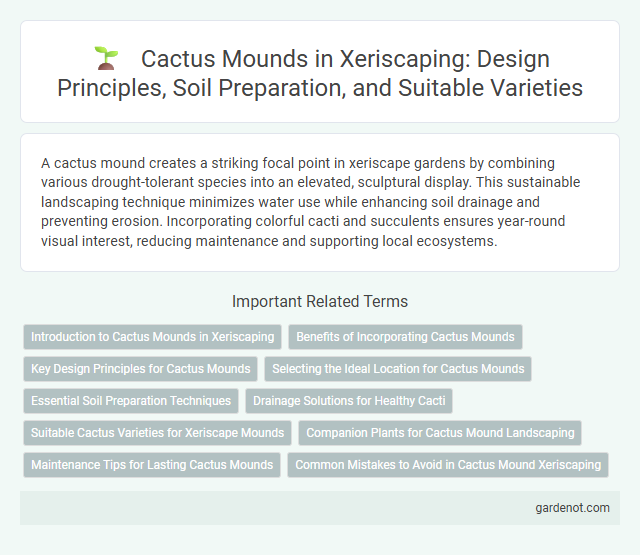A cactus mound creates a striking focal point in xeriscape gardens by combining various drought-tolerant species into an elevated, sculptural display. This sustainable landscaping technique minimizes water use while enhancing soil drainage and preventing erosion. Incorporating colorful cacti and succulents ensures year-round visual interest, reducing maintenance and supporting local ecosystems.
Introduction to Cactus Mounds in Xeriscaping
Cactus mounds serve as essential focal points in xeriscaping, providing drought-tolerant landscaping solutions that conserve water while adding unique texture and height to garden designs. These mounds, composed of well-draining soil and arranged with various cactus species, enhance soil aeration and reduce erosion, promoting sustainable plant growth in arid environments. Integrating cactus mounds into xeriscapes supports native biodiversity and minimizes maintenance by creating resilient, water-efficient landscapes.
Benefits of Incorporating Cactus Mounds
Cactus mounds enhance xeriscape gardens by conserving water through drought-resistant plants, reducing irrigation needs by up to 80%. These formations improve soil stability, preventing erosion and promoting healthy root systems in arid environments. Incorporating cactus mounds also supports local biodiversity, providing habitat for pollinators like bees and butterflies.
Key Design Principles for Cactus Mounds
Cactus mounds thrive by incorporating well-drained soil and strategic placement to maximize sun exposure, essential for healthy growth and vibrant blooms. Utilizing layers of coarse sand, gravel, and organic matter enhances root aeration and prevents water retention, aligning with xeriscape principles. Grouping cacti with similar water and light needs optimizes irrigation efficiency and maintains a visually cohesive, drought-tolerant landscape.
Selecting the Ideal Location for Cactus Mounds
Choosing the ideal location for cactus mounds involves selecting areas with full sun exposure and well-draining soil to prevent root rot and promote healthy growth. Elevating the mound slightly improves drainage, mimicking natural desert conditions essential for cactus survival. Positioning the mound away from heavy foot traffic and frost-prone zones ensures durability and long-term sustainability in xeriscape landscapes.
Essential Soil Preparation Techniques
For a successful cactus mound, essential soil preparation techniques include selecting well-draining, sandy or gravelly soil to prevent root rot and ensure moisture control. Incorporate organic matter such as compost sparingly to improve soil aeration without retaining excess water. Elevating the mound enhances drainage, promoting healthier cactus growth in xeriscaping environments.
Drainage Solutions for Healthy Cacti
Cactus mounds enhance drainage by elevating soil above ground level, preventing water accumulation that causes root rot in cacti. Incorporating coarse sand, gravel, and organic matter in the mound's soil mix further improves water permeability and aeration. Properly designed drainage solutions in cactus mounds ensure healthy root systems and promote drought-resistant growth essential for xeriscaping success.
Suitable Cactus Varieties for Xeriscape Mounds
Suitable cactus varieties for xeriscape mounds include species like the golden barrel cactus (Echinocactus grusonii), prickly pear (Opuntia spp.), and cholla (Cylindropuntia spp.). These cacti thrive in arid conditions, require minimal water, and offer architectural interest with their unique shapes and textures. Incorporating drought-tolerant cacti enhances water efficiency and sustainability in xeriscape mound designs.
Companion Plants for Cactus Mound Landscaping
Companion plants for cactus mound landscaping include drought-tolerant species such as agave, yucca, and lavender which complement the arid environment and enhance visual appeal. Succulents like sedum and echeveria thrive alongside cacti, providing varied textures and colors while requiring minimal water. Incorporating native grasses like blue grama or muhly grass adds movement and contrast, promoting a balanced and sustainable xeriscape design.
Maintenance Tips for Lasting Cactus Mounds
Cactus mounds require well-draining soil and minimal watering to prevent root rot, making them ideal for xeriscape gardens. Regularly remove weeds and debris to enhance airflow and reduce pests, while applying a balanced fertilizer during the growing season supports healthy growth. Pruning damaged or overgrown segments helps maintain the mound's shape and encourages new cactus shoots.
Common Mistakes to Avoid in Cactus Mound Xeriscaping
Common mistakes in cactus mound xeriscaping include overwatering, which can cause root rot and fungal diseases, and planting cacti too closely, leading to poor air circulation and increased pest problems. Using heavy, clay soils instead of well-draining sandy or rocky substrates disrupts the natural water retention essential for cactus health. Failing to account for sun exposure often results in sunburned or etiolated plants, impacting their growth and aesthetic appeal.
Cactus mound Infographic

 gardenot.com
gardenot.com